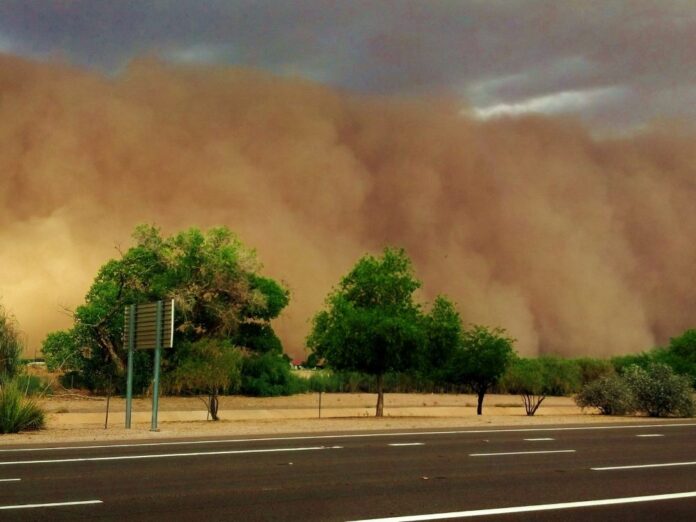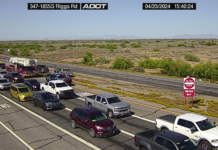
Those who have lived in Arizona are prepared for it, as they see it nearly every summer. But for the many newcomers to Maricopa, driving in a monsoon storm, dust storm or haboob can be intimidating.
A menacing wall of dust appears in the distance, suddenly blocking the sun as visibility drops to almost nothing. Blasts of wind scatter tree branches that block traffic lanes and dust gives way to torrents of rain that flood roadways.
Drivers who don’t know how to respond can be shaken, stranded or even injured. That’s why the Arizona Department of Transportation is holding Monsoon Awareness Week this week and sharing important safety information, so motorists are prepared for dust storms and severe weather. Since 2008, the National Weather Service has established monsoon season as running from June 15 through Sept. 30.
ADOT’s most important advice is the simplest: “Pull Aside, Stay Alive.”
To help drivers minimize hazardous situations or injuries, motorists should keep in mind some practical tips to avoid the worst of the severe storm season:
- Avoid driving into or through a dust storm
- If you encounter a dust storm, immediately check traffic around your vehicle and begin slowing down
- Don’t wait until poor visibility makes it difficult to pull off the road – pull aside as soon as possible and exit the highway if possible
- Don’t stop in a travel lane or in the emergency lane. Look for a safe place to pull completely off the paved portion of the roadway
- Turn off all vehicle lights, including emergency flashers. You don’t want other vehicles approaching from behind to use your lights as a guide, possibly crashing into your parked vehicle
- Set your emergency brake and take your foot off the brake
- Stay in the vehicle with your seat belts buckled and wait for the storm to pass
- Drivers of high-profile vehicles should be especially aware of changing weather conditions and travel at reduced speeds
ADOT’s efforts to promote safety include an innovative, first-of-its-kind dust detection system along a 10-mile section of Interstate 10 between Eloy and Picacho Peak. Motorists traveling in this area will see electronic variable speed limit signs, overhead message boards and weather radar that work together to warn drivers of reduced visibility or approaching storms.
If blowing dust reduces visibility to levels that affect safe travel, the system automatically reduces speed limits from 75 mph to as low as 35 mph. Also, overhead message boards will warn drivers of reduced visibility and the need to slow down for safety.
The system first went into use in 2020 and successfully activated itself during dust events. Data from sensors in the roadway show drivers slow down when variable speed limit signs drop the posted speed limit, thereby helping drivers move through the area more safely.
More information on dust storm safety can be found at PullAsideStayAlive.com. Real-time highway conditions are available on ADOT’s Travel Information Center at az511.gov, by calling 511 and through ADOT’s Twitter feed @ArizonaDOT.





![Maricopa’s ‘TikTok Rizz Party,’ explained One of several flyers for a "TikTok rizz party" is taped to a door in the Maricopa Business Center along Honeycutt Road on April 23, 2024. [Monica D. Spencer]](https://www.inmaricopa.com/wp-content/uploads/2024/04/spencer-042324-tiktok-rizz-party-flyer-web-218x150.jpg)






![Alleged car thief released without charges Phoenix police stop a stolen vehicle on April 20, 2024. [Facebook]](https://www.inmaricopa.com/wp-content/uploads/2024/04/IMG_5040-218x150.jpg)




